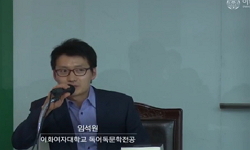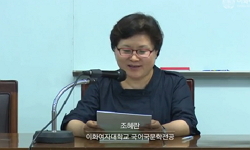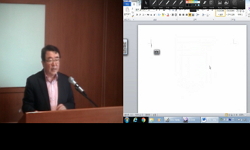Hamjong(咸從) Eossi(魚氏) family was one of military families residing in Dongnae(東萊) county. They emigrated and settled down in Dongnae county around the Japanese invasions of Korea (1592-1598) and manchu invasions of Korea(1627, 1636). The f...
http://chineseinput.net/에서 pinyin(병음)방식으로 중국어를 변환할 수 있습니다.
변환된 중국어를 복사하여 사용하시면 됩니다.
- 中文 을 입력하시려면 zhongwen을 입력하시고 space를누르시면됩니다.
- 北京 을 입력하시려면 beijing을 입력하시고 space를 누르시면 됩니다.

조선후기 동래거주 함종(咸從) 어씨(魚氏)의 무임(武任) 가문(家門)으로의 성장과 그 사회문화적 의의 = The growth of Hamjong Eossi(咸從 魚氏)`s family who Lived in Dongnae(東萊) county as a military family in the Late Chosun Dynasty and its sociocultural meaning
한글로보기https://www.riss.kr/link?id=A60214470
- 저자
- 발행기관
- 학술지명
- 권호사항
-
발행연도
2012
-
작성언어
-
-
주제어
19세기 ; 동래부 ; 함종 어씨 ; 무임 ; 사회 이동 ; 사회적 분화 ; 중군 ; 무청선생안 ; 부청선생안 ; 19th century in Korea ; Dongnae ; 東萊 ; Hamjong(咸從) Eeossi(魚氏) family ; military officer(武任) ; Choonggoon ; 中軍 ; the highest rank of military officer ; social mobility ; Social differentiation ; Mucheongseonsaen
-
KDC
900
-
등재정보
KCI등재
-
자료형태
학술저널
-
수록면
197-226(30쪽)
- DOI식별코드
- 제공처
- 소장기관
-
0
상세조회 -
0
다운로드
부가정보
다국어 초록 (Multilingual Abstract)
Hamjong(咸從) Eossi(魚氏) family was one of military families residing in Dongnae(東萊) county. They emigrated and settled down in Dongnae county around the Japanese invasions of Korea (1592-1598) and manchu invasions of Korea(1627, 1636). The family are Known as military family but their inside is much more complicated than expectation. The family is dived into three pedigrees that originated from three sons of Eo, Shin-Gae(魚信개) the progenitor of the family in Dongnae county. Each pedigree is very different in the aspect of social status of its descendants. At the first, descendants of Eo, Bong-In(魚奉仁) the oldest son held not only military officer but also local clerk(吏胥). Originally their position as military officer was mainly low-ranking. But suddenly after the mid-nineteenth century, they got the Choonggoon(中軍) the highest rank of military officer and local clerk(吏胥). The next oldest son-Eo, Bong-Seon(魚奉善)`s descendants also started from low military officer and sometimes they had higher positions such as Byeoljang(別將), Baekchong(百摠). But since then, there`s no record of them so regarded as ruined. The youngest son-Eo, Bong-IL(魚奉日)`s pedigree is very special. Their start was not that different from others in the aspect of low-ranking military officer. However, they`ve made great effort for the seven generation including passing of mukwa(武科及第) and getting a citation for filial conduct. By those things, they`ve got through higher status and in the mid-nineteenth century, finally turned out the Choonggoon(中軍). In these process, they drew family tree and participated in publication of genealogy. These things were done for establishing the family`s noble identity as a posterity of yangban(兩班). And by receiving the citation, they were recognized as the people who practiced well confucianism, regarded as that only yangban could practice, by yangban. On the other hand, there is a noticeable fact in the genealogy. 60% of Eossi who recorded on Mucheongseonsaengan(武廳先生案), the book which records the name of military officer, and Bucheongseonsaengan(府廳先生案), the book which records the name of local clerk(吏胥), weren`t found in the genealogy. In Chosun Dynasty, putting one`s name on a genealogy was very important because it reflected one`s social status. So take these things into consideration, the fact that 60% of the family couldn`t put their names on the record means they mostly were ruined. Aspiration for higher status and collapse of sociocultural status, these two antithetic concepts are not only shown in the Hamjong Eossi`s case but also reflect social differentiation of military groups in Dongnae county. These differentiation appeared not in turbulent times like war but in peaceful time. It shows that the system of Dongnae county could be stable in such a dynamic and gradual social movement.
동일학술지(권/호) 다른 논문
-
중국(中國) 고대(古代) 목간(木簡)의 서명(署名) 방식 연구
- 한국고문서학회
- 박준호 ( Jun Ho Park )
- 2012
- KCI등재
-
16~17세기 경상도(慶尙道) 자인현(慈仁縣) 복현(復縣) 과정과 이를 둘러싼 자인(慈仁),경주(慶州) 지역 재지사족의 동향
- 한국고문서학회
- 이광우 ( Gwang Woo Yi )
- 2012
- KCI등재
-
17세기 경주 유향소의 위상: 경주이씨 양월문중 소장 고문서의 분석
- 한국고문서학회
- 김현영 ( Hyun Young Kim )
- 2012
- KCI등재
-
- 한국고문서학회
- 박성호 ( Sung Ho Park )
- 2012
- KCI등재




 KCI
KCI KISS
KISS







